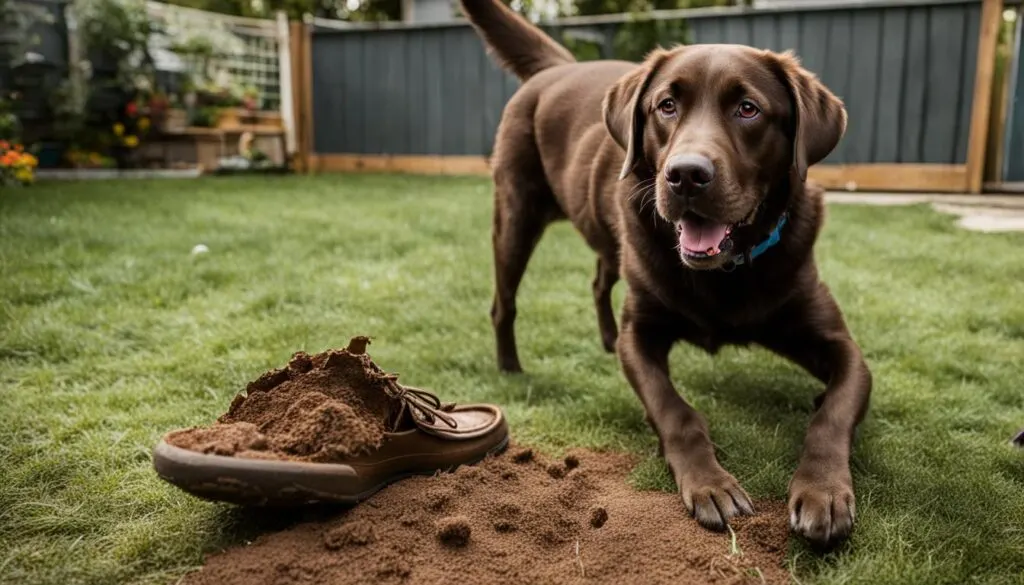Did you know that Labrador Retrievers are among the most popular dog breeds in the United States?
With their friendly nature and playful disposition, it’s no wonder they’re a favorite choice for pet owners.
However, like any other dogs, Labradors can face behavior issues that can strain the pet-owner relationship.
From aggression and fear to excessive barking and chewing, these behavior problems can be frustrating and challenging to overcome.
Fortunately, with the right training and guidance, many of these issues can be effectively addressed, leading to a happier and more harmonious life with your Labrador.
Click Here to Jump to a Section
Key Takeaways:
- Labrador Retrievers are one of the most popular dog breeds in the United States.
- Labradors can face a variety of behavior issues, including aggression, fear, excessive barking, and chewing.
- Addressing behavior problems in Labradors requires a combination of basic obedience training, retraining, and professional help.
- Positive reinforcement and redirection are effective techniques for modifying behavior in Labradors.
- Considerations such as health issues should also be taken into account when addressing behavior problems in Labradors.

Aggression in Labradors: Causes and Solutions
Aggression is one of the most common behavior complaints among dog owners and can pose serious challenges if not addressed appropriately.
Labradors, known for their friendly and gentle nature, can occasionally exhibit aggression, which can be concerning for pet owners.
Understanding the causes and implementing effective solutions is key to managing aggression in Labradors.
Aggression in Labradors can manifest in various ways, including teeth baring, growling, and even aggressive attacks.
The underlying causes of aggression can be complex and multifaceted, but fear is often a significant trigger.
It’s essential to identify the root cause of aggression to develop an appropriate behavior modification plan.
When dealing with aggression in Labradors, seeking professional help from experienced trainers or behaviorists is highly recommended.
These professionals utilize positive techniques to enhance the dog’s confidence, trust, and feelings of safety.
They will assess the specific aggressive behavior patterns and tailor a behavior modification program accordingly.
A rigorous retraining approach is often employed to modify aggressive behaviors in Labradors.
This may involve desensitization and counter-conditioning techniques, where the dog is gradually exposed to the trigger in a controlled and supervised environment.
Positive reinforcement, such as rewards and praise, is used to reinforce desired behaviors and redirect the dog’s response to potential triggers.
Common Causes of Aggression in Labradors:
- Fear or anxiety
- Possessiveness over resources
- Territorial instincts
- Pain or discomfort
- Past traumatic experiences
Effective Strategies for Addressing Aggression:
- Seek professional help from trainers or behaviorists
- Practice positive reinforcement techniques
- Implement behavior modification plans
- Identify and manage potential triggers
- Provide a safe and secure environment
It’s important to note that managing aggression in Labradors requires patience, consistency, and ongoing dedication. With the right approach and professional guidance, the aggressive behavior can be effectively modified, leading to a happier and safer relationship between the Labrador and its owner.
Addressing Fear and Anxiety in Labradors
Fear and anxiety are common behavior issues in Labradors that can significantly impact their well-being and quality of life. These issues can manifest in various ways, such as fear of going on walks, cowering and shaking near people or other dogs, or displaying anxious behaviors when separated from their owners. It’s essential for dog owners to understand how to address and manage labrador separation anxiety and other anxiety-related behaviors in order to provide a safe and comfortable environment for their furry friends.
To effectively address fear and anxiety in Labradors, it is highly recommended to seek professional help from trainers or behaviorists who specialize in working with anxious dogs. These professionals can provide valuable insights and customized training programs to help reduce fear responses and increase confidence in Labradors.
Trainers who offer one-on-one and in-home training sessions can work closely with Labradors and their owners to develop behavior modification plans tailored to their specific needs.
By employing positive reinforcement techniques and gradual desensitization, trainers can help Labradors build confidence and overcome their anxiety triggers.
In addition to professional assistance, there are several labrador training tips that can be followed to help alleviate fear and anxiety:
- Establish a consistent routine: Labradors thrive on routine, so establishing a daily schedule can help provide them with a sense of security and stability.
- Create a safe space: Designate a quiet and comfortable area in your home where your Labrador can retreat to when they feel anxious or overwhelmed.
- Provide mental and physical stimulation: Engage your Labrador in regular exercise, interactive games, and puzzle toys to help keep their minds stimulated and reduce anxiety.
- Practice obedience training: Teaching basic obedience commands and reinforcing positive behaviors can help build your Labrador’s confidence and promote a sense of security.
- Avoid reinforcing anxious behavior: While it may be tempting to comfort your anxious Labrador, it’s important to avoid reinforcing anxious behaviors by rewarding or providing attention when they are exhibiting signs of fear or anxiety.
Remember, addressing fear and anxiety in Labradors requires patience, consistency, and professional guidance.
With the right approach and support, you can help your furry companion feel more secure and confident, leading to a happier and healthier life.
Tips for Addressing Fear and Anxiety in Labradors
| Tips | Description |
|---|---|
| Establish a consistent routine | Create a daily schedule to provide Labradors with a sense of security and stability. |
| Create a safe space | Designate a quiet and comfortable area in your home where your Labrador can retreat to when they feel anxious or overwhelmed. |
| Provide mental and physical stimulation | Engage Labradors in regular exercise and interactive games to reduce anxiety and keep their minds stimulated. |
| Practice obedience training | Teach basic obedience commands to build confidence and promote a sense of security. |
| Avoid reinforcing anxious behavior | Avoid rewarding or providing attention when Labradors are exhibiting signs of fear or anxiety. |
Managing Excessive Barking in Labradors
Excessive barking can be a common behavior problem in Labradors that can disrupt the peace and harmony in your home. Addressing and managing this issue is crucial for a well-behaved and happy Labrador. Here are some effective strategies and tips to help you tackle labrador barking issues:
1. Avoid scolding or punishing your Labrador:
Scolding or punishing your Labrador for barking excessively may unintentionally reinforce the behavior.
Instead, focus on positive methods of training to redirect their barking towards more appropriate behaviors.
2. Teach your Labrador to bark on command:
One way to control excessive barking is to teach your Labrador to bark on command.
This can be done by using a verbal cue, such as saying “speak,” and rewarding them for barking when given the command.
This helps establish control over their barking behavior.
3. Teach a “quiet” or “shh” command:
Once your Labrador understands the “speak” command, you can then introduce a cue for them to stop barking, such as “quiet” or “shh”.
When they stop barking upon hearing this command, reward them with treats or praise.
Consistency is key in reinforcing this command.
4. Provide mental and physical stimulation:
Excessive barking can sometimes be a result of boredom or lack of mental and physical stimulation.
Make sure your Labrador gets regular exercise, playtime, and interactive toys to keep them mentally stimulated and physically tired, reducing the likelihood of excessive barking.
5. Seek professional help:
If your Labrador’s excessive barking persists despite your efforts, it may be beneficial to seek guidance from a professional dog trainer or behaviorist.
They can provide personalized training plans and techniques to address the specific underlying causes of the excessive barking.
Remember, training and managing excessive barking in Labradors requires patience, consistency, and positive reinforcement.
With the right approach, you can help your Labrador become a well-behaved and calm member of your family.
| Causes | Solutions |
|---|---|
| Loneliness or boredom | Provide mental and physical stimulation through play, exercise, and interactive toys. |
| Anxiety or fear | Consult a professional trainer or behaviorist to address anxiety or fear-related barking. |
| Guarding territory | Teach your Labrador to respond to “quiet” or “shh” command. |
| Attention-seeking behavior | Ignore the barking and reward your Labrador when they are calm and quiet. |
| Medical issues | Consult a veterinarian to rule out any underlying medical conditions. |
Dealing with Digging and Chewing in Labradors
Digging and chewing are natural behaviors for Labradors, but they can become problematic if they are a result of separation anxiety or boredom.
Labradors may resort to digging and chewing as a way to cope with their emotions or alleviate boredom.
To address these behaviors and ensure the well-being of your Labrador, it is important to provide alternative outlets and redirect their behavior towards more appropriate activities.
Designated Digging Areas
Labradors may dig out of instinct or as a way to release excess energy.
Creating a designated digging area in your backyard can help satisfy their natural urge to dig while preserving your garden or yard.
Choose an area where your Labrador can freely indulge in digging without causing any damage. Bury some favorite toys or treats in the designated area to make it more enticing for your dog.
Appropriate Chew Toys
Labradors have a strong need to chew, especially during their teething phase.
Providing them with appropriate chew toys can redirect their chewing behavior away from your furniture and belongings.
Choose durable toys specifically designed for heavy chewers and ensure they are safe for your Labrador to chew on. Additionally, rotate the toys to keep them interesting and engaging for your dog.
Positive Reinforcement
Positive reinforcement is an effective training technique that can be utilized to encourage desired behavior in Labradors.
Whenever you catch your Labrador avoiding destructive chewing or digging in inappropriate areas, offer verbal praise or a small treat as a reward.
This will help reinforce the idea that choosing the designated digging area or appropriate chew toys is more rewarding.
By providing alternative outlets, redirecting their behavior, and using positive reinforcement, you can effectively address digging and chewing issues in Labradors.
Remember, consistency and patience are key when training your Labrador, and seeking professional help from a trainer or behaviorist is recommended if the behavior persists.

Training Labradors to Stop Leash Pulling and Jumping Up
Leash pulling and jumping up are common behavior problems in Labradors that can be addressed through training. Teaching Labradors to walk nicely on a leash and not pull can be achieved through positive reinforcement, such as praise, treats, or the use of a clicker. Consistently rewarding desired behaviors, like walking without pulling, can help discourage leash pulling.
When it comes to jumping up, ignoring the behavior and only giving attention when the dog is calm and not jumping can help discourage this behavior. Techniques like redirecting the dog to a sit command can also be effective in addressing jumping up.
Training Labradors to stop leash pulling and jumping up requires consistency, patience, and the right techniques.
By using positive reinforcement and redirecting unwanted behaviors, you can help your Labrador become a well-behaved and obedient companion.
Addressing Resource Guarding and Begging in Labradors
Resource guarding and begging are common behavior problems in Labradors that can be addressed through behavior modification techniques.
Resource guarding is when a dog displays possessive behavior over food, toys, or other valuables, often resulting in potential aggression.
To address resource guarding in Labradors, professional training is recommended.
Trainers can use positive reinforcement techniques to teach the dog that giving up possessions can lead to positive experiences.
By associating rewards with relinquishing items, Labradors can learn to let go of their possessive behaviors.
Begging behavior can also be addressed through consistent rules and boundaries.
Labradors should not be fed from the table, as this can reinforce begging.
Ignoring the behavior and not providing attention or food rewards is important in reducing begging tendencies.
Additionally, positive reinforcement and redirecting the dog’s attention to appropriate behaviors can help reduce begging.
By rewarding the Labrador for staying calm and not begging, they will learn that alternative behaviors are more beneficial.

Managing Whining and Lack of Response to Commands in Labradors
Whining and not responding to commands are common behavior problems that Labradors may exhibit.
These issues can be addressed through obedience training, consistent training techniques, and positive reinforcement.
By establishing clear commands and expectations, Labradors can learn to respond effectively and minimize whining behavior.
Professional trainers can offer valuable guidance on effective training techniques specific to addressing whining and improving response to commands.
Training Techniques to Address Whining Behavior:
- Consistency: Stick to a regular training schedule to reinforce desired behavior and discourage whining.
- Positive Reinforcement: Reward Labradors with treats, praise, or toys when they respond appropriately to commands.
- Clear Commands: Use simple, consistent commands to ensure Labradors understand what is expected of them.
- Patient Approach: Avoid frustration and remain patient throughout the training process, as it may take time for Labradors to understand and respond consistently.
Improving Response to Commands:
- Focus and Engagement: Train Labradors in environments with minimal distractions, allowing them to concentrate on the commands.
- Use Positive Reinforcement: Reward Labradors when they respond promptly and accurately to commands.
- Progressive Training: Start with basic commands and gradually introduce more complex ones, ensuring Labradors understand and respond appropriately at each stage.
- Consistent Practice: Reinforce commands regularly through practice sessions, reinforcing the desired response.
Remember, patience and consistency are key when training Labradors to minimize whining and improve their response to commands. With proper obedience training techniques and professional guidance, Labradors can become well-behaved pets who respond positively to commands and communicate effectively with their owners.

Considering Health Issues in Labradors with Behavior Problems
When addressing behavior problems in Labradors, it is essential to take into account potential health issues that may contribute to their behavior.
Certain changes in behavior can be indicative of underlying pain or other medical conditions.
Seeking a comprehensive assessment from a veterinarian can help rule out any health concerns and ensure that the appropriate steps are taken to address the behavior problems effectively.
Labrador behavior assessment is crucial in determining whether there are any underlying health issues impacting their behavior.
By conducting a thorough examination, the veterinarian can evaluate the dog’s physical health and identify any potential medical conditions or sources of discomfort.
This assessment may involve tests, such as blood work or imaging, to gain a comprehensive understanding of the dog’s health.
It is important to note that addressing behavior problems alone may not resolve the issue if there is an underlying medical condition.
By considering labrador health issues and seeking veterinary guidance, pet owners can address any underlying health concerns in conjunction with behavior modification strategies.

Common Health Issues in Labradors
| Health Condition | Symptoms |
|---|---|
| Arthritis | Lameness, difficulty walking or climbing stairs, stiffness |
| Ear Infections | Head shaking, scratching at ears, redness or discharge |
| Obesity | Weight gain, decreased activity, difficulty breathing |
| Dental Disease | Bad breath, swollen gums, tooth loss |
| Allergies | Itching, redness, hair loss, recurrent ear infections |
Labradors are prone to certain health issues that can have an impact on their behavior.
Arthritis, for example, can cause pain and discomfort, leading to changes in mobility and temperament.
Ear infections, obesity, dental disease, and allergies are also common health issues that can affect their overall well-being and behavior.
By understanding and addressing these health conditions, pet owners can create a more supportive environment for their Labradors’ overall behavior modification.
Veterinary guidance and appropriate medical interventions can complement behavior training and help improve the quality of life for Labradors with behavior problems.
Seeking Professional Help for Labradors’ Behavior Issues
While basic training and at-home strategies can be effective in addressing certain behavior problems in
Labradors, there are instances where seeking professional help becomes necessary.
Behavior counseling and modification provided by specialized trainers can offer tailored strategies and techniques to address each dog’s specific needs.
In more severe cases, veterinary behaviorists can provide professional consultations and develop behavior modification plans to tackle complex behavior issues.
By engaging the expertise of a labrador behaviorist or professional trainer, pet owners can gain valuable insights into their labrador’s behavior and receive guidance on implementing effective behavior modification techniques.
These professionals can accurately assess the dog’s behavior, identify underlying triggers, and provide the necessary guidance and support to improve the labrador’s behavior.
Through labrador behavior counseling, a professional can help pet owners understand their labrador’s behavior patterns, empower them with training strategies, and address specific concerns.
Behaviorists can also provide guidance on how to manage challenging behaviors and prevent potential issues from escalating.
With their expertise, labrador behaviorists and trainers can significantly contribute to a more harmonious and balanced relationship between pet owners and their labradors.
It’s important to note that seeking professional help for labrador behavior issues should be regarded as a proactive step towards addressing and resolving these problems effectively.
With the right professional guidance, pet owners can work towards long-term behavior modification and ensure the overall well-being and happiness of their labradors.
Setting Up a Supportive Environment for Labradors’ Behavior Modification
When it comes to addressing behavior problems in Labradors, creating a supportive environment is key.
By providing mental and physical stimulation through interactive games, regular exercise, and obedience training, you can help prevent and alleviate these issues. E
ngaging your Labrador in stimulating activities not only keeps them physically active but also provides an outlet for their energy, reducing the likelihood of negative behaviors.
Consistency is crucial in training your Labrador.
By establishing clear expectations and using positive reinforcement techniques, such as treats and verbal praise, you can reinforce desired behaviors and deter unwanted ones.
It’s important to redirect your Labrador’s attention when they exhibit undesirable behavior and reward them when they respond positively to commands or exhibit good behavior.
It’s important to acknowledge that addressing behavior problems takes time and effort.
In some cases, seeking external support from behavior resources can be beneficial.
Professional trainers, local obedience classes, and veterinary clinics with behavior programs can provide additional guidance and resources to help manage your Labrador’s behavior issues effectively.
These resources offer tailored advice and assistance based on their expertise, helping you and your furry friend achieve a closer, more harmonious bond.
Remember, managing behavior problems in Labradors requires a combination of patience, consistency, and access to relevant resources.
By providing a supportive environment and seeking assistance from appropriate behavior management sources, you can successfully address and overcome behavior issues in your beloved Labrador.
